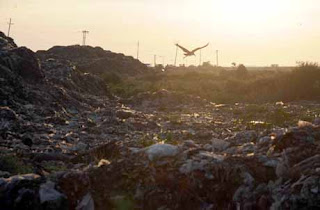It has been happening forever- whenever there is a problem, the
silent and almost invariably, the innocent has to suffer the most. Until, of
course, nature turns nemesis. And when a city with an area of just a little
over 500 square kilometres has to house a population of over a million, there
is a problem. A big one at that. Resources are pushed to a catastrophic hilt till finally everything starts to fall
apart and threatens to engulf with it all that ever was- the bubble of growth,
the façade of modernization and the pretense of development.
Guwahati is a town in evolution. From a small sleepy town of the
80s to the hub of trade and commerce of North East India that it is today, the
transformation has been drastic and very palpable.The Chief Minister would
proudly add that it is, in fact, the 5th fastest growing city in the
country. The development is encouraging and has actually opened up a world of
avenues in the city with international retail chains setting shops everywhere
in the city. Very impressive indeed for a place where the waters of the great
river that flows through it, had for so long, reeked of neglect and from the
rest of the country
.
 But almost ironically, Deepor
Beel, an abandoned channel of the might river itself and a wetland of immense
significance for the city stinks of apathy from its own people now. An
unexpected population explosion and its ugly aftermath have taken its toll on
the lone Ramsar site of the state and
the consequences are for all to be seen and felt today. A very dangerous
development for the city that has been ,over the past decade or so, moving a
tad too fast.
But almost ironically, Deepor
Beel, an abandoned channel of the might river itself and a wetland of immense
significance for the city stinks of apathy from its own people now. An
unexpected population explosion and its ugly aftermath have taken its toll on
the lone Ramsar site of the state and
the consequences are for all to be seen and felt today. A very dangerous
development for the city that has been ,over the past decade or so, moving a
tad too fast.
Beel means a
wetland or a large aquatic body in Assamese and Deepor Beel is one of the largest and most important riverine
wetlands in Assam's Brahmaputra valley and is representative of the wetlands
found within the Burma Monsoon Forest biogeographic region. Spread over an area
of 41.4 square kilometeres with varying depths of 4 meteres to 1 metre, this
freshwater wetland is home to a diverse range of flora and fauna. The fauna
here includes many an International Union for the Conservation of Nature (IUCN)
red listed species such as the Spot-billed Pelican ,the Baers Pochard , the Lesser Adjutant Stork , the Pallas’s Sea Eagle, the Slender-billed Vulture
, the Ferruginous Duck , the Greater Adjutant Stork ,the Asiatic Elephant
,the Irriwaddy Squirrel, and the Hoolock
Gibbon. Deepor Beel also happens to be one of the largest staging sites for
migratory birds in India and a winter morning here is any avian fauna
enthusiast’s dream or at least, used to be.
 |
| A dump yard right next to Deepor Beel |
The Beel, bluntly put, is in shambles
today. Reduced to a dump yard of a callous city, the filth in the lake cuts a pathetic picture. A newly constructed
railroad, along the southern boundary of
Deepor Beel, fragments the two previously dependent ecosystems, Deepor Beel and
Rani/ Garbhanga Reserved Forests, a
development that could spell disaster
for the already much abused wetland. Unplanned and non-regulated fishing
practices are making things worse. And to top it all, since the city has no
space left , industrial and residential developments are starting to
proliferate a little too close to the wetland. And as for the mayhem we as a
species are capable of inflicting on nature, the lesser said or written about it,
the better it is .With humans at action, poaching and soil cutting within the
wetland have also become rampantly common.
Deepor Beel is dying a slow and
painful death. What is even sadder is that it will probably fade off noiselessly
without the rest of the country ever having known of its existence, like so
many other things in the state of Assam. The helpless pleas of the Beel for some attention have, for long,
muffled by the bombs and grenades of the ULFA and the NDFB for perhaps, that is
what we, as a race wanted the world to know and acknowledge us for. And now,
beneath the comatose splendor of showrooms of designer labels and the sleek
interiors of multi cuisine restaurants, what is actually ours is suffering
under the heartless indifference of its own people. If the
Beel is to die, which it will in the present scheme of things, the blotch
of apathy and ungratefulness on the collective consciousness of the state would
stay with us to haunt us forever. The Beel has to be saved, for it is
indispensable to our existence as a state and more importantly, as a part of
Mother Nature.